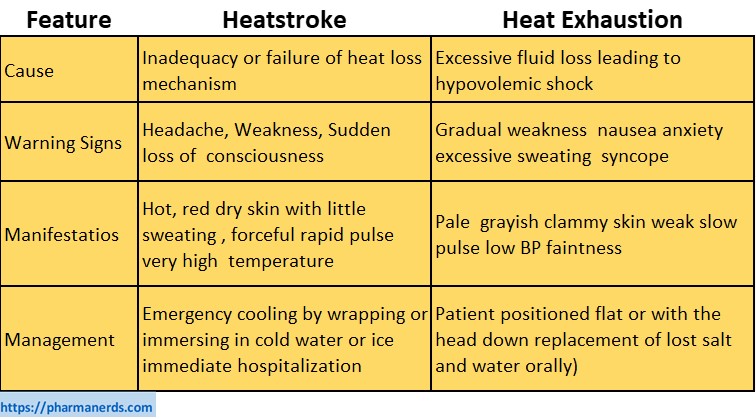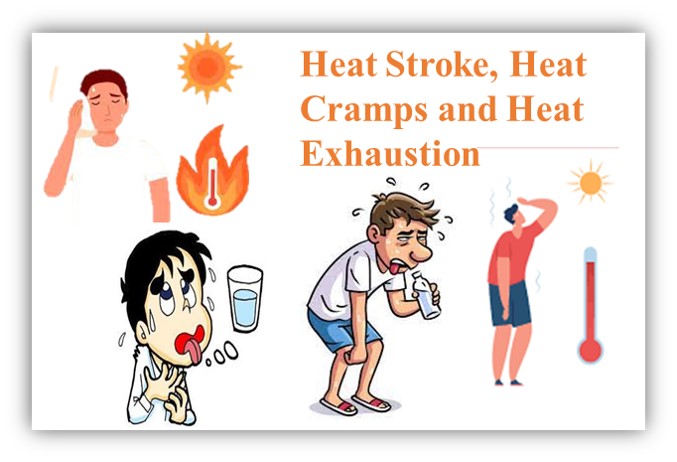Introduction to Heat Disorders
Heat disorder is a mild to grave reactions to high environmental temperature due to inadequate or inappropriate responses of heat regulating mechanisms. Exposure to high ambient temperature without efficient heat loss may lead to heal cramps, heatstroke, or heat exhaustion.
The higher the humidity, the less efficient the heat loss. Therefore, high ambient humidity (Which decreases the cooling effect of sweating) and prolonged strenuous exertion (Which increase heat production by muscle) increase the risk of developing heat disorders.
Age, obesity chronic alcoholism, debility, and many drugs (e.g. anticholinergics, antihistamines, phenothiazines, numerous psychoactive drugs, alcohol, cocaine) increase susceptibility to heat disorders, numerous psychoactive drugs, alcohol, and cocaine) increase susceptibility to heat disorders, particularly heatstroke. Heatstroke and heat exhaustion both occur in hot; humid environments, but they are markedly different disorders (See Table below).
Differentiating heatstroke and heat exhaustion:

Prevention of heat Disorders
Using common sense is best strenuous exertion in a very hot environment or in inadequately ventilated space should be avoid and heavy insulating clothing should not be worn. If exertion in a hot environment is unavoidable, fluid and electrolytes (Often lost imperceptibly in very hot very dry air) should be replaced by frequently drinking fluids slightly salty to taste (i.e., near isotonic) and evaporation , which helps the ski8n cool should be facilitated by wearing open mesh clothing or using fans. Thirst is a poor indicator of dehydration .During strenuous exercise; fluids should be drunk every hour regardless of thirst.
Heat Stroke
Definition:
It is a response to heat characterized by high body temperature and disturbance of sweating mechanism. It is an immediate, life threatening emergency, which urgently needs medical care.
Signs and Symptoms of Heat Stroke
- Hot red and dry skin (fig.43), because the sweating mechanism is blocked.
- The victim may be unconscious.
- An abrupt onset is sometimes preceded by headache, vertigo, and fatigue.
- Sweating is usually decreased, and the skin is hot flushed and usually dry.
- The pulse rate increases rapidly and may reach 160 to 180 beats/min: respiration usually increase but Bp seldom affected.
- Disorientation may briefly precede unconsciousness or convulsions.
- The temperature climbs rapidly to 40 to 410 C , causing a feeling of burning up.
- Circulatory collapse may precede death after hours of extreme hyperpyrexia, survivors are likely to have permanent brain damage.
First Aid Measures
The first-aider should focus towards immediate measures to cool the body quickly. However, take care of over chilling of the victim once his temperate is reduced below 380c. The following first aid measures are applicable whenever the body temperature reaches 40.5 degree Celsius.
- Repeated sponging of the bare skin with cool water or rubbing alcohol.
- Apply cold packs continuously
- Place the victim in a tub of cold water (do not add ice) until his temperature is lowered sufficiently.
- When the victim’s temperature has been reduced enough, dry him off with a towel.
- Use fans or air conditioners, if available, since drafts will promote cooling.
- If the victim’s temperature starts to go up again, start the cooling process again.
- Do not give the victim stimulants.
Heat Cramps
Heat cramps occur after exercise at higher ambient temperature (>38 degree Celsius) when fluids lost through excessive sweating are replaced only by water. The result is a relative loss of sodium and occasionally potassium and magnesium. Heat crumps are common in manual laborers (e.g. engine room personnel, steelworkers, miners, diggers), in tennis players and other weakened athletes, and in persons not acclimatized to hot, dry climates in which excessive sweating is almost undetected because of rapid evaporation.
It involves muscular pains and cramps due to loss of large amount of salt from the body in sweating or due to inadequate intake of salt. It may be associated also with heat exhaustion.
Assessment findings (Signs and symptoms)
- Onset is often abrupt, with muscles of extremities affected first.
- Crumps are brief, intense, and tend to occur during rest after exercise or heavy labour.
- Nausea, tachycardia, pallor, weakness, and profuse diaphoresis are often present.
- The condition is seen most often in healthy, acclimated athletes with inadequate salt intake.
- Sever pain and carpopedal spasm may incapacitate the hands and feet.
- Often episodic, the cramping makes the muscles feel like hard knots.
- When the cramps affect only abdominal muscles, the pain may simulate an acute abdomen.
- Vital signs are usually normal
- The skin may be hot and dry or clammy and cool, depending on the humidity.
First Aid Measures
- Cramps resolve rapidly with rest and oral replacement of sodium and water.
- Elevation, gentle massage, and analgesia minimize pain associated with heat cramps
- The patient should avoid strenuous activity for at least 12 hours after the development of heat cramps.
- Education should emphasize salt replacement during strenuous exercise in hot, humid environment.
- Apply firm pressure with hands on the cramped muscles, or gently massage them to help relieve the pain.
- Give the victim sips of salt water 1 teaspoonful of salt in a liter of cool boiled water (half a glass every 15 minutes over a period of about 1 hour).
Heat Exhaustion
Excessive fluid and electrolyte loss due to sweating, resulting in hypovolemia and electrolyte imbalance. It is a response to heat characterized by fatigue, weakness and collapse due to intake of water inadequate to compensate for loss of fluids through sweating.
Assessment findings
- Pale and clammy skin
- Profuse perspiration
- Nausea, dizziness (possible vomiting)
- Possible fainting, but the victim probably gains his consciousness as his head is lowered.
- Excessive sweating without concomitant fluid replacement cases heat exhaustion with increasing fatigue, headache, weakness and anxiety.
- Circulatory collapse ensues, with slow, thready pulse, slow perceptible blood pressure; cold, pale, clammy skin, and disorientation followed by shock like unconsciousness.
- Core temperature ranges from 38.3 to 40.6 degree Celsius. are due to dehydration.
- Mild heat exhaustion, precipitated by prolonged standing in hot environment (because blood pools in heat – dilated vessels in the legs), is manifested by a subnormal body temperature and simple syncope.
First Aid Measures
- Give the victim sips of salt water 1 teaspoonful of salt per liter of cool boiled water. (half a glass every 15 minuets, over a period of about one hour).
- Have the victim lie down and raise his feet from 20 to 30 cm.
- Loosen the victim’s clothing
- Apply cool, wet clothes or take him to an air conditioned room.
- If the victim vomits, do not give him any more fluids and take to hospital as soon as possible.
- After an attack of heat exhaustion, advise the victim not to return to work for several days and see that he is protected from exposure to abnormally warm temperature.

